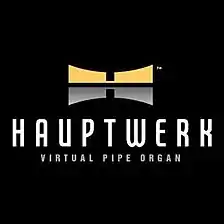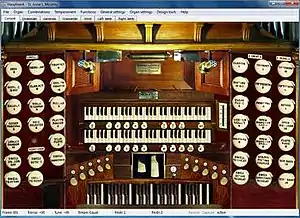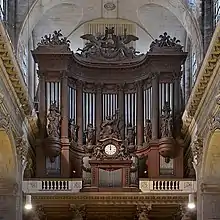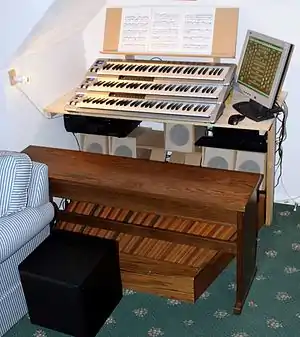Hauptwerk
Hauptwerk is a computer program, available from Milan Digital Audio, designed to allow the playback or live performance of pipe organ music using MIDI and recorded sound samples. The program is a commercial product and is available as a monthly subscription or a perpetual license.
 | |
| Developer(s) | Milan Digital Audio |
|---|---|
| Stable release | 6.1
/ 2020 November 21 |
| Operating system | Microsoft Windows, Mac OS X |
| Website | hauptwerk |
Name
‘Hauptwerk’ is the German term for the great manual of an organ, from Haupt- (‘main’) and Werk (literally: ‘work’ or ‘opus’, here roughly ‘[power] plant’, ‘factory’, some place where something, a sound in this case, is produced). The German pronunciation of the word ‘Hauptwerk’ is [ˈhaʊ̯ptˌvɛʁk].[1]
History
Hauptwerk was originally developed and launched in 2002 by Martin Dyde who, starting 2006, continued to develop it trading as Crumhorn Labs Ltd.[2][3]
In September 2008 Crumhorn Labs and Hauptwerk were acquired by Brett Milan of Milan Digital Audio LLC.[4]
Product history

Version 1
Released 2002
- Available for Windows only
- Stops operated by MIDI Note messages
- Simple Swell simulation (volume only)
- Organ of St Annes, Moseley included
Version 2
Released 2006 [5]
- Available as VSTi plugin
- More flexibility in MIDI configuration
- Phase alignment of release samples
- Harmonic Swell simulation
Version 3
Released November 2007 [6]
- Support for Mac OS X
- Support for Multiple Touch-Screens
- Voicing Control for individual pipes
Version 4
Released April 2011 [7]
- Redesigned User Interface
- Automatic facility to configure MIDI to support most manufacturers
- Inbuilt MIDI recorder/player
- User defined Combinations/Crescendos
- Master Couplers available with all organs
Version 5
Released December 2019
- Redesigned Audio Output Routing
- 3D Sound output
- Impulse Response reverb capabilities
- Removed Free Edition
Version 6
Released November 2020
- Menu changes
- Combination system changes
- MIDI changes
- Audio engine changes
- Small changes + bug fixes[8]
Methodology
.jpg.webp)
Hauptwerk produces an audio signal in response to input received via MIDI. This input may originate from an external MIDI keyboard or from a MIDI sequencing program. An organ is constructed using a set of recorded sample files in conjunction with an XML configuration file that defines organ parameters such as ranks, stops, manuals, coupling and organ images for display in Hauptwerk's user interface.
The audio output is based on recorded samples which are then modified by several different technologies.[9]
Sample playback
The recorded samples of the original pipes are divided into 3 main sections - start(attack), middle(sustain) and end(release or echo). When a note is played the attack sample is played followed by a loop of the sustain section. Start, end and release loop points are stored in the recorded sample file. When the note is released, the release or echo section of the sample is used, or specific release sample files can be defined for a note, or range of notes. This latter feature is useful in making the organ more realistic, for example the echo of a pipe after a short period will be different from that of a pipe that has been sounding for longer. Hauptwerk can select from multiple release samples based on the duration of the note. Tremulant effects are possible using LFO sample files to dynamically modify the sound, avoiding the need to create individual tremulant note sample files.
Harmonic filtering
When an organist moves an Expression pedal it affects both the volume and frequency envelope of the affected pipes. Hauptwerk adjusts both of these parameters using information provided within the sample-set. This can be based on measurements taken from the original instrument.
Physical modeling
The wind-pressure applied to an organ pipe affects its volume, pitch and character. Hauptwerk uses Fluid dynamics to model the movement of air through the various parts of a pipe-organ. This information is then used to modify the sampled sound.
Randomization
Randomization is used to modify certain aspects of the audio output. The pitch of individual pipes can be randomly modified when a sample is loaded into memory. If multiple loop points are provided, in the sustain section of a sample, these are selected randomly. Additionally, Hauptwerk simulates some other effects, such as Wind Turbulence, using Randomization during playback.
Organ sample-sets

Since the launch of Hauptwerk, a number of independent companies have recorded organs and made these available for use with Hauptwerk. By March 2009 more than 50 organs had been recorded. These include some notable organs in many different countries including:[10]
- Bavokerk, Haarlem, Netherlands
- Bovenkerk, Kampen, Netherlands
- Eglise de Saint Etienne, Caen, France
- Laurenskerk, Rotterdam, Netherlands
- Palace of Arts (Budapest), Hungary
- Salisbury Cathedral, UK
- Stadtkirche, Waltershausen, Germany
- Martinikerk, Groningen, Netherlands
- Melbourne Town Hall, Australia
Salisbury Cathedral
In March 2009, Milan Digital Audio announced that permission had been given to record the Father Willis organ at Salisbury Cathedral, UK.[11]
Starting 23 February 2010 the Salisbury Cathedral pipe organ was temporarily unavailable, due to maintenance work scheduled to last one month. During this time a console based on Hauptwerk was used to provide organ music for cathedral services.[12][13]
According to an article on the Salisbury Cathedral website: "Over the past few weeks we have used the organs from Metz Cathedral, France, St Georgenkirche, Roetha, Germany, and Our Lady of Mt. Carmel, Chicago, IL., USA". The article continues: "Volume I of our very own Father Willis Organ was released by Milan Digital Audio just days before my organ was installed into the cathedral which has allowed me to use 28 of the 65 stops of the Father Willis organ in its natural acoustic. It is believed to be the first time a sampled instrument has been used in its own building for services!"[14][15]
Composite Sample Sets
The custom organ design module allows hauptwerk users to create custom organs by mixing two or more existing sample sets to create a custom organ. One can select certain ranks from one organ and from another and combine them to create a personal and unique organ, while also adding enhanced features and voicing which the original sample sets do not offer. Examples include:
- Aristide no. 1 (Hauptwerk-organ.com)
- Grand Symphonic Composite
- Composite of Saint Sulpitius (Organa Reginae Caeli)
- Composite of Our Lady of Paris (Organa Reginae Caeli)


Copy protection older versions and iLok

Hauptwerk was copy protected using the HASP USB token (dongle) from Aladdin Knowledge Systems.
The USB token was used to control the functionality of the single Hauptwerk program which was licensed in 3 editions:[16]
- Free edition – Free download and use without USB token but limited to 1.5GB sample memory and 256 polyphony, stereo output.
- Basic edition – Purchased license with USB token. Up to 3GB sample memory and 1024 polyphony
- Advanced edition – Purchased license with USB token. No imposed memory or polyphony limit, multiple audio channels and MIDI output.
The USB token was also used by some companies to enforce license conditions of individual sample sets. This may apply to the release of historic recordings with restrictions on the customization and re-use of the sounds.[17]
Since the release of Hauptwerk version 5, Hauptwerk is using the licensing platform iLok by Pace Anti Piracy. Now there are only 2 editions:
- Lite - Subscription license, limited to 1024 polyphony
- Advanced - Subscription or Perpetual license.
See also
References
- Concerning the pronunciation compare Wiktionary: Haupt and German Wiktionary: Werk.
- "Original Hauptwerk UK Website". 2002. Archived from the original on 2002-08-08. Retrieved 2010-03-05.
- "Original Crumhorn Labs Website". 2006. Archived from the original on 2006-07-10. Retrieved 2010-03-05.
- "Acquisition Announcement". 2008. Retrieved 2010-03-05.
- "Hauptwerk Version 2 - Features". 2006. Archived from the original on 2006-05-24. Retrieved 2010-03-05.
- "Hauptwerk Version 3 Announcement". 2006. Archived from the original on 2007-11-05. Retrieved 2010-03-05.
- "Hauptwerk Version 4 Features" (PDF). 2011. Retrieved 2011-08-19.
- "Hauptwerk 6.0.1 Release Notes Download Page". Hauptwerk.
- "Hauptwerk Version 4 Features Datasheet" (PDF). 2010. Retrieved 2010-11-11.
- "PCorgan - List of Sample Sets". 2010. Retrieved 2010-03-07.
- "Hauptwerk Forum Announcement". 2009. Retrieved 2010-03-05.
- "Salisbury Cathedral News - February 2008" (PDF). Retrieved 2010-03-05.
- "Salisbury Journal Article". Retrieved 2010-03-05.
- "Salisbury Cathedral Website - News 12 March 2010". Archived from the original on 2012-03-20. Retrieved 2010-03-18.
- "Vision News South - Video Report". Retrieved 2010-03-23.
- "Hauptwerk - Feature Comparison" (PDF). 2010. Retrieved 2010-03-05.
- "OrganArt - License Agreement". 2010. Retrieved 2010-03-08.
External links
- Hauptwerk
- PCorgan - Site with comprehensive information about Hauptwerk and links to many related sites (available in Dutch and English)
- contrebombarde - Site with over 25,000 audio recordings made using Hauptwerk
- Music Site - a site with illustrations for building a console and with explanations of how Hauptwerk works
- "All about Hauptwerk", Kenneth A Spencer. ISBN 978-1-326-31884-0. 244 pages - A detailed guide to Hauptwerk